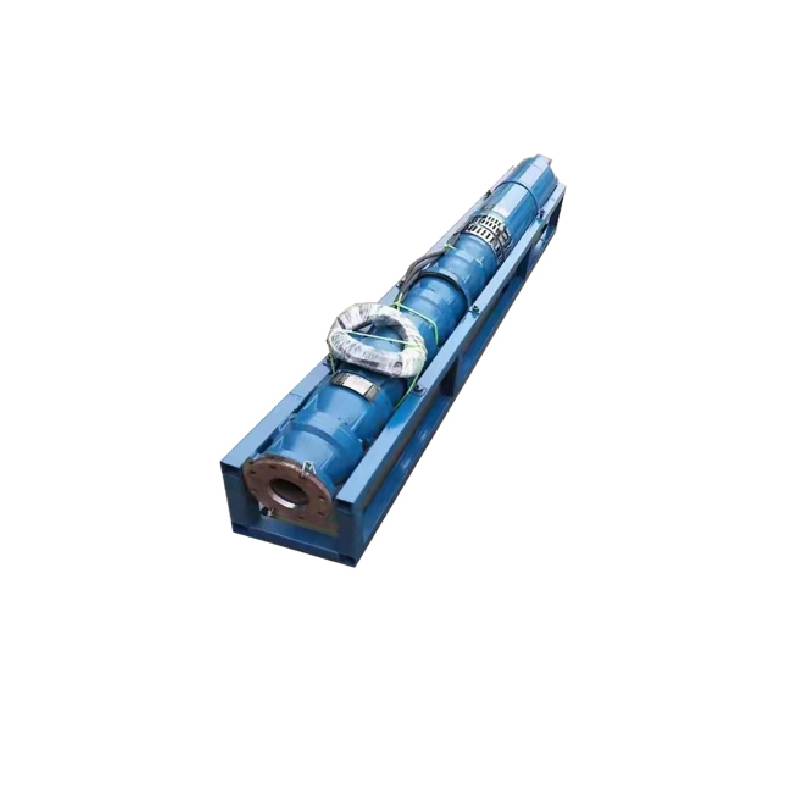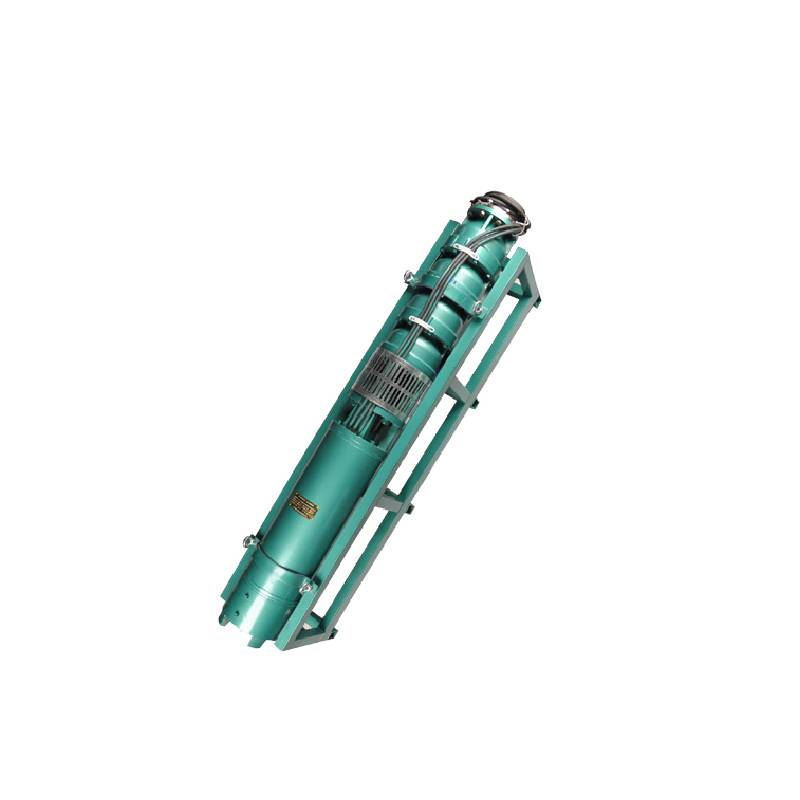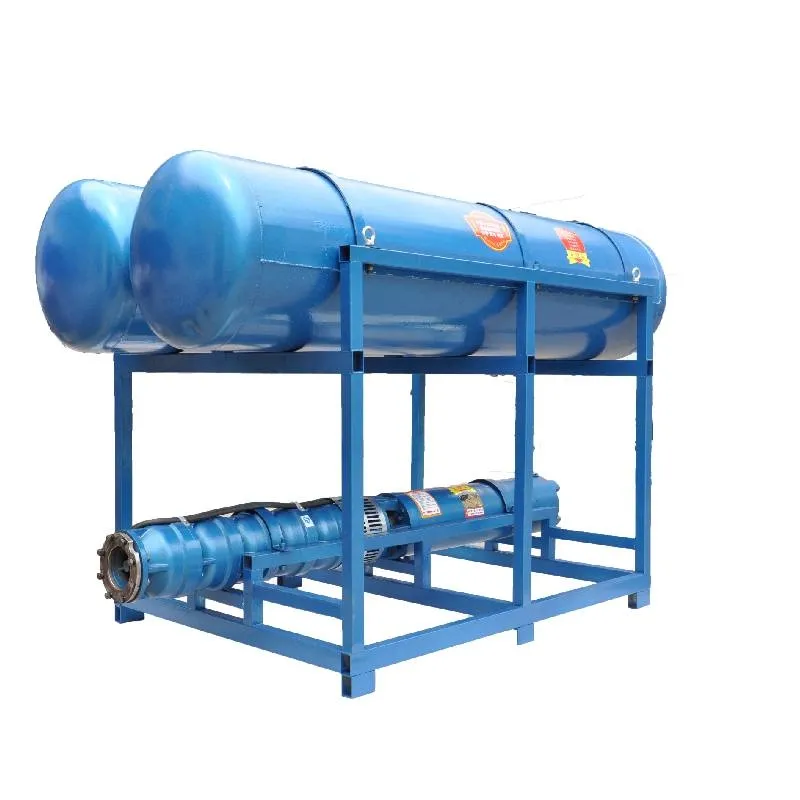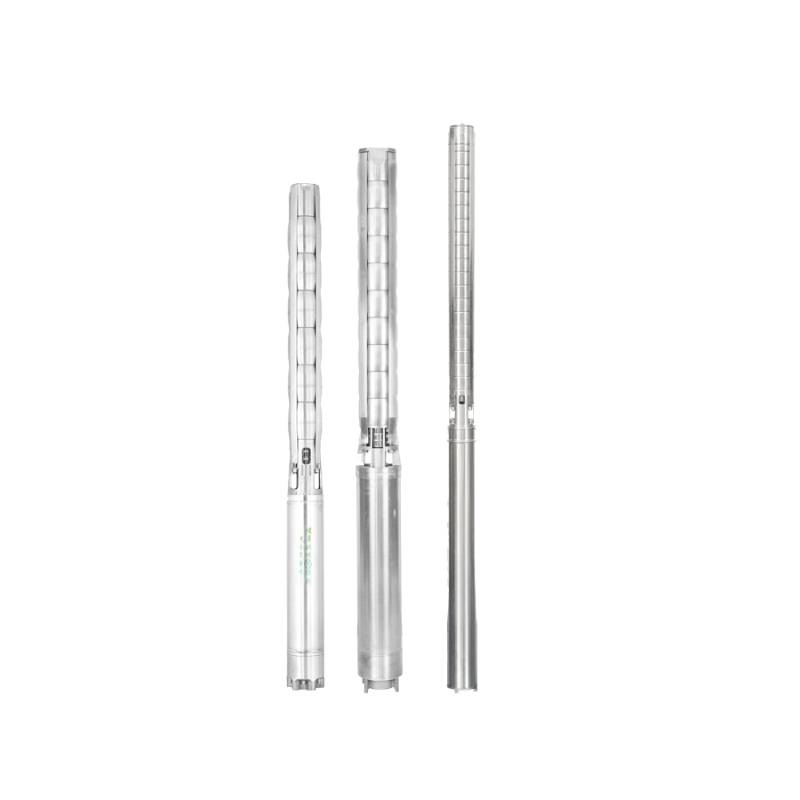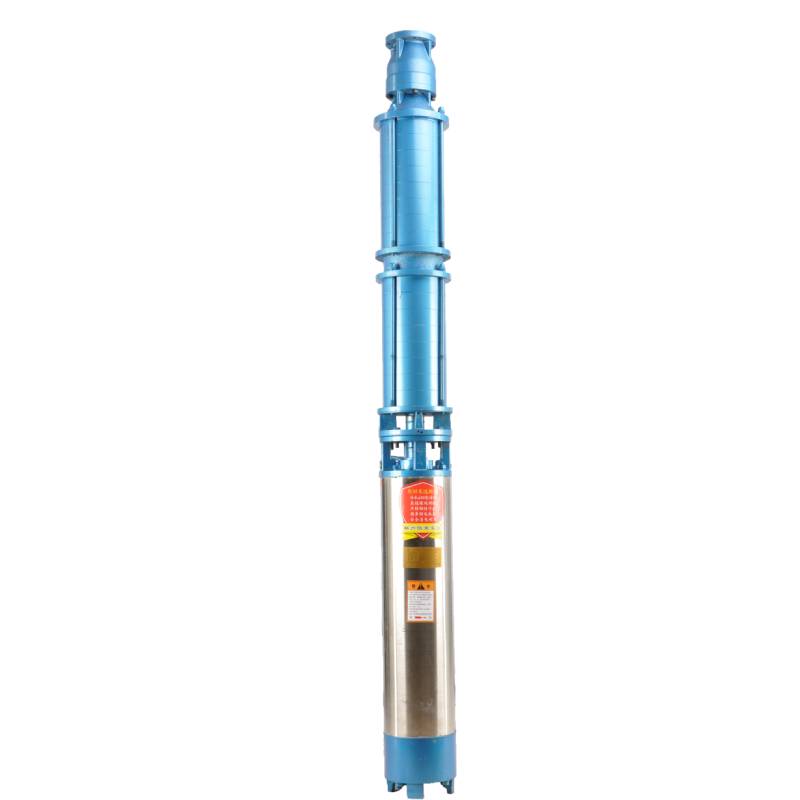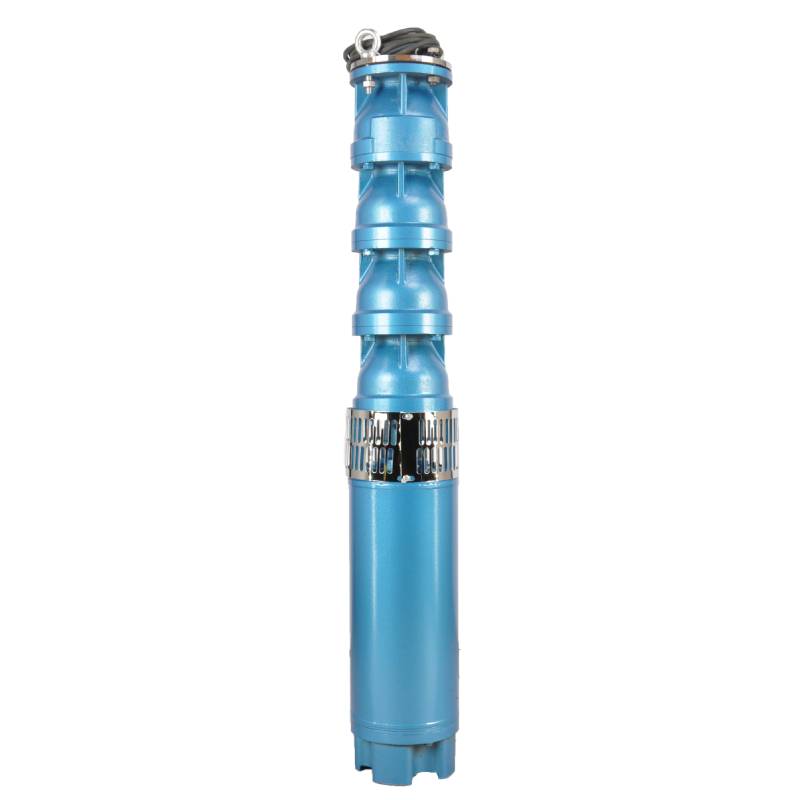Introducing the innovative QJP series fountain pump, a product of superior efficiency meticulously developed and researched by our factory. With a meticulously designed pump motor core crafted from premium cold rolled silicon steel, this fountain pump boasts exceptional magnetic conductivity, enabling seamless and heat-free starts. Unlike traditional fountain pumps, the 0JP series features motor rotor ends that utilize a unique water-lubricated alloy copper sleeve, replacing standard ball bearings. This innovative design not only mitigates issues of rust and wear caused by lack of oil but also ensures longevity and durability for the motor. Upgrade your fountain experience with the cutting-edge technology and superior performance of the QJP series fountain pump.
The product is a three-phase AC 380V (tolerance + / - 5%), 50HZ (tolerance + / - 1%) power supply, and has strict requirements for clean water: water temperature shall not exceed 20 °C; solid impurities content (mass ratio) shall not exceed 0.01%; PH value (pH) is 6.5-8.5; hydrogen sulfide content shall not exceed 1.5mg/L; chloride ion content shall not exceed 400mg/L. The product adopts a closed or water immersion structure motor, the submersible motor must be filled with clean water before use to prevent empty. In addition, the water can be used after filling and tightening the air release bolt. The submersible pump must be completely immersed in water to work, the diving depth shall not exceed 70m, and the distance between the bottom of the pump and the bottom of the well shall not be less than 3m. The well water flow should meet the water output and continuous operation requirements of the submersible pump, and the water output shall be controlled at 0.7-1.2 times of the rated flow. The well must be vertical, and the submersible pump can not be used horizontally, and it must be installed vertically. The submersible pump must match the cable as required and be equipped with external overload protection device. It is strictly prohibited to do no-load test without water.
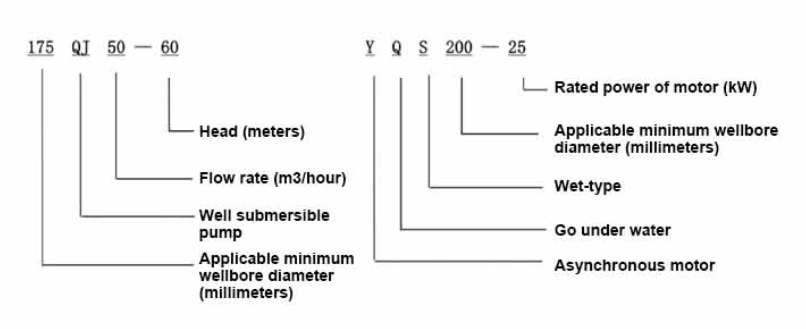
| Tauira | Rere (m3/h) | Upoko (m) |
Tere hurihuri (hurihia/tohu) |
Puma wai(%) | Putanga diameter (mm) |
E tika ana diameter(mm) |
Whakatauria mana(KW) |
Whakatauria ngaohiko(V) |
Whakatauria nāianei(A) |
Te Motika (%) | power factorcosφ | Waeine Rahi Morahi Radial(mm) |
Korero | |||||||||
| 135QJ5-34 | 5 | 34 | 2850 | 40 | 135runga | 1.5 | 380 | 4.23 | 128 | |||||||||||||
| 135QJ5-51 | 51 | 2.2 | 6.03 | |||||||||||||||||||
| 135QJ5-68 | 68 | 3 | 8.01 | |||||||||||||||||||
| 135QJ5-85 | 85 | 4 | 10.53 | |||||||||||||||||||
| 135QJ5-102 | 102 | 5.5 | 14.1 | |||||||||||||||||||
| 135QJ5-119 | 119 | 5.5 | 14.1 | |||||||||||||||||||
| 135QJ5-240 | 240 | 11 | 26.28 | |||||||||||||||||||
| 135QJ5-280 | 5 | 280 | 2850 | 40 | 135runga | 13 | 380 | 30.87 | 128 | |||||||||||||
| 135QJ5-320 | 320 | 15 | 35.62 | |||||||||||||||||||
| 135QJ10-24 | 10 | 24 | 2850 | 50 | 135runga | 1.5 | 380 | 4.23 | 128 | |||||||||||||
| 135QJ10-32 | 32 | 2.2 | 6.03 | |||||||||||||||||||
| 135QJ10-48 | 48 | 3 | 8.01 | |||||||||||||||||||
| 135QJ10-56 | 56 | 4 | 10.53 | |||||||||||||||||||
| 135QJ10-72 | 72 | 5.5 | 14.1 | |||||||||||||||||||
| 135QJ10-80 | 80 | 5.5 | 14.1 | |||||||||||||||||||
| 135QJ10-104 | 104 | 7.5 | 19.0 | |||||||||||||||||||
| 135QJ10-120 | 120 | 7.5 | 19.0 | |||||||||||||||||||
| 135QJ10-136 | 136 | 9.2 | 22.7 | |||||||||||||||||||
| 135QJ10-180 | 180 | 11 | 26.28 | |||||||||||||||||||
| 135QJ10-210 | 210 | 13 | 30.87 | |||||||||||||||||||
| 135QJ10-240 | 240 | 15 | 35.62 | |||||||||||||||||||
| 135QJ10-300 | 300 | 18.5 | 43.12 | |||||||||||||||||||
| 135QJ15-36 | 15 | 36 | 2850 | 50 | 135runga | 2.2 | 380 | 6.03 | 128 | |||||||||||||
| 135QJ15-39 | 39 | 3 | 8.01 | |||||||||||||||||||
| 135QJ15-46 | 46 | 4 | 10.53 | |||||||||||||||||||
| 135QJ15-52 | 52 | 4 | 10.53 | |||||||||||||||||||
| 135QJ15-59 | 59 | 5.5 | 14.1 | |||||||||||||||||||
| 135QJ15-65 | 65 | 5.5 | 14.1 | |||||||||||||||||||
| 135QJ15-78 | 78 | 7.5 | 19.0 | |||||||||||||||||||
| 135QJ15-91 | 91 | 7.5 | 19.0 | |||||||||||||||||||
| 135QJ15-104 | 104 | 9.2 | 22.7 | |||||||||||||||||||
| 135QJ15-120 | 120 | 11 | 26.28 | |||||||||||||||||||
| 135QJ15-142 | 142 | 13 | 30.87 | |||||||||||||||||||
| 135QJ15-162 | 162 | 15 | 35.62 | |||||||||||||||||||
| 135QJ15-200 | 200 | 18.5 | 43.12 | |||||||||||||||||||
| 135QJ20-16 | 20 | 16 | 2850 | 50 | 135above | 2.2 | 380 | 6.03 | 128 | |||||||||||||
| 135QJ20-24 | 24 | 3 | 8.01 | |||||||||||||||||||
| 135QJ20-32 | 32 | 4 | 10.53 | |||||||||||||||||||
| 135QJ20-40 | 40 | 4 | 10.53 | |||||||||||||||||||
| 135QJ20-48 | 48 | 5.5 | 14.1 | |||||||||||||||||||
| 135QJ20-56 | 56 | 5.5 | 14.1 | |||||||||||||||||||
| 135QJ20-64 | 64 | 7.5 | 19.0 | |||||||||||||||||||
| 135QJ20-72 | 72 | 7.5 | 19.0 | |||||||||||||||||||
| 135QJ20-80135QJ20-100 | 80 | 9.2 | 22.7 | |||||||||||||||||||
| 100 | 11 | 26.28 | ||||||||||||||||||||
| 135QJ20-120 | 120 | 13 | 30.87 | |||||||||||||||||||
| 135QJ20-136 | 136 | 15 | 35.62 | |||||||||||||||||||
| 135QJ20-168135QJ25-12 | 168 | 18.5 | 43.12 | |||||||||||||||||||
| 25 | 12 | 2850 | 65 | 135runga | 2.2 | 380 | 6.03 | 128 | ||||||||||||||
| 135QJ25-18 | 18 | 3 | 8.01 | |||||||||||||||||||
| 135QJ25-24 | 24 | 4 | 10.53 | |||||||||||||||||||
| 135QJ25-30 | 30 | 4 | 10.53 | |||||||||||||||||||
| 135QJ25-36 | 36 | 5.5 | 14.1 | |||||||||||||||||||
| 135QJ25-48 | 48 | 7.5 | 19.0 | |||||||||||||||||||
| 135QJ25-60 | 60 | 9.2 | 22.7 | |||||||||||||||||||
| 135QJ25-82 | 82 | 11 | 26.28 | |||||||||||||||||||
| 135QJ25-97 | 97 | 13 | 30.87 | |||||||||||||||||||
| 135QJ25-110 | 110 | 15 | 35.62 | |||||||||||||||||||
| 135QJ25-130 | 130 | 18.5 | 43.12 | |||||||||||||||||||
| 135QJ32-24 | 32 | 24 | 2850 | 80 | 135runga | 4 | 380 | 10.53 | 128 | |||||||||||||
| 135QJ32-30 | 30 | 5.5 | 14.1 | |||||||||||||||||||
| 135QJ32-42 | 42 | 7.5 | 19.0 | |||||||||||||||||||
| 135QJ32-54 | 54 | 9.2 | 22.7 | |||||||||||||||||||
| 135QJ32-68 | 68 | 11 | 26.28 | |||||||||||||||||||
| 135QJ32-80 | 80 | 13 | 30.87 | |||||||||||||||||||
| 135QJ32-92 | 92 | 15 | 35.62 | |||||||||||||||||||
| 135QJ32-104 | 104 | 18.5 | 43.12 | |||||||||||||||||||
| 135QJ40-46 | 40 | 46 | 2850 | 80 | 135runga | 11 | 380 | 26.28 | 128 | |||||||||||||
| 135QJ40-54 | 54 | 13 | 30.87 | |||||||||||||||||||
| 135QJ40-62 | 62 | 15 | 35.62 | |||||||||||||||||||
| 135QJ40-84 | 84 | 18.5 | 43.12 | |||||||||||||||||||
Well submersible pump is a clean water pump, it is strictly prohibited to dig a new well to extract mud and silt. The voltage grade of the well pump is 380/50HZ, and the submersible motor with other voltage grades needs to be customized. Underground cables must be waterproof and must be equipped with starting equipment, such as distribution box, etc. Starting equipment should have common motor comprehensive protection functions, such as short circuit overload protection, phase loss protection, undervoltage protection, grounding protection and idling protection, etc. In abnormal cases, the protection device should be timely tripping. When installing and using the pump, the pump must be reliably grounded, and it is prohibited to push and pull the switch when the hands and feet are wet. Before installing and maintaining the pump, the power must be cut off, and the place where the pump is used must be clearly marked "anti-electric shock". Before going down the well or installing the pump, the motor must be filled with distilled water or clean cold water without corrosion, and the intake/drain bolts must be tightened. When testing the pump on the ground, water must be poured into the pump chamber to lubricate the rubber bearings. The instant start time should not exceed one second to check whether the direction is correct. When using the pump, the lift and flow range specified by the pump must be strictly followed to prevent the pump from having a large flow at low lift or a large pull at high lift, which will lead to serious wear and tear of the thrust bearing and other parts and components, and cause the motor to overload and burn out. After the pump is put into the well, the insulation resistance between the motor and the ground should be measured, which should not be less than 100MΩ. After the start, the voltage and current should be observed regularly, and the motor winding insulation should be checked to see if it meets the requirements; if the temperature of the pump storage location is below the freezing point, the water in the motor cavity should be drained to prevent the water in the motor cavity from freezing and damaging the motor due to low temperature.
Kupu whakataki poto o te hanganga: wahi papu te nuinga tito o papu manga, impeller, anga diversion, rapa whanau, taki takirere tinana (wahanga kōwhiringa) me ētahi atu wāhanga.Motor te nuinga tito o te turanga, te pēhanga te whakarite kiriata, te turaki whanau, te pereti pana. , te nohoanga kaiarahi o raro, te stator, te rotor, te nohoanga kaiarahi o runga, te mowhiti kirikiri, te waahanga whakauru wai, te taura me etahi atu waahanga.
Ko nga ahuatanga matua o te hua ko:
1, Ko te motini he miihini whakakikorua e toru-waahanga makuku ki tonu i te wai, kua ki tonu te kohao motuka i te wai ma, ka whakamahia hei whakamatao i te motuka me te whakahinuhinu i te whanau, ka whakamahia te pehanga pehanga kiriata kei raro o te motuka hei whakatika. te roha me te rereke o te pehanga o te wai i roto i te tinana na te huringa o te pikinga o te pāmahana o te motuka.
2, Hei aukati i te onepu i roto i te puna wai kia uru ki roto i te motuka, ko te pito o runga o te motuka motuka e mau ana ki nga hiri hinu e rua, ka whakauruhia he mowhiti kirikiri hei hanga i te hanganga aukati kirikiri.
3, Hei aukati i te rere o te papa papu i te wa e tiimata ana, ka honohia te papa papu me te motuka motuka e te hono, ka whakauruhia he peera o runga ki te taha o raro o te motuka.
4, Ko te whakahinuhinu o te motini me te papu e mau ana he whakahinuhinu wai.
5, Ko te motika stator awhiowhio he mea hanga o te kounga teitei submersible moto awhiowhio waea, ki te mahi insulation tiketike.
6, Ko te papu e hangaia ana e te CAD rorohiko, me te hanganga ngawari me te mahi hangarau pai.

(1) Whakaritenga i mua i te whakaurunga:
1. Tirohia mehemea ka tutuki te papu ruku ki nga tikanga whakamahi me te whanuitanga kua tohua ki te pukapuka.
2. Ma te whakamahi i te obiect taumaha me te diameter e rite ana ki te teitei o te diameter o waho o te papu ruku, ine mehemea ka uru te inneldiameter o te poka wai ki te papu ruku, me te ine mena ka tutuki te hohonutanga o te puna ki nga whakaritenga whakaurunga.
3. Tirohia mehemea he ma te rua o te puna me te wai pokarekare ranei. Kaua rawa e whakamahia he papu hiko ruku ki te horoi i te paru welor papu me te wai kirikiri kia kore e pakaru wawe te papu hiko ruku.
4. Tirohia mehemea he pai te tuunga o te rawhi whakaurunga welhead me te kaha ki te tu ki te kounga o te waahanga katoa.
5. Tirohia mehemea kua oti te whakaurunga o nga waahanga papu ruku me te tika kia rite ki te hoahoa huinga i roto i te pukapuka Tangohia te mata tātari ka huri i te hononga kia kite mena ka huri ngawari.
6. Wewetehia te wiri wai ka whakakiia te kohao motopaika ki te wai ma, kaua e pirau (tohu. me whakakiia ki runga), katahi ka whakakaha i te kopa wai. I muri i nga haora 12 o te werohia o te wai, kaua e iti iho i te 150M Q te parenga whakamarumaru o te motini ka ine ki te tepu wiri 500V.
7. Cable joint, cut off a 120mm rubber sleeve from one end of the outgoing cable and the matching cable with an electrician's knifethen stagger the length of the three core wires in a stepped shape, peel off a 20mm copper core, scrape of the oxide layer on theoutside of the copper wire with a knife or sand cloth, and insert the two connected wire ends in palirs.After tying the layer tightly with fine copper wire, solder it thoroughly and firmly, and sand of any. burrs on the surface. Then, forthe three joints, use polyvester insulation tape to wrap them in a semi stacked manner for three lavers. Wrap the two ends of thewrapping layer tightywith nyion thread,and then use a semi stacked method to wrap the tape for three layers. Wrap the outellayer with high-pressure insulation tape for three layers. Finally, fold the threestrands together and repeatedly wrap them for fivelayers with high-pressure tape. Each layer must be tightly tied, and the interlayer joints must be tight and fimm to prevent water frompenetrating and damaging the insulation, After wrapping, soak in water at room temperature of 20 ’c for 12 hours, and measurethe insulation resistance with a shaking table, which should not be less than 100M Ω
Ko te hoahoa tukanga waea waea kua honoa e whai ake nei: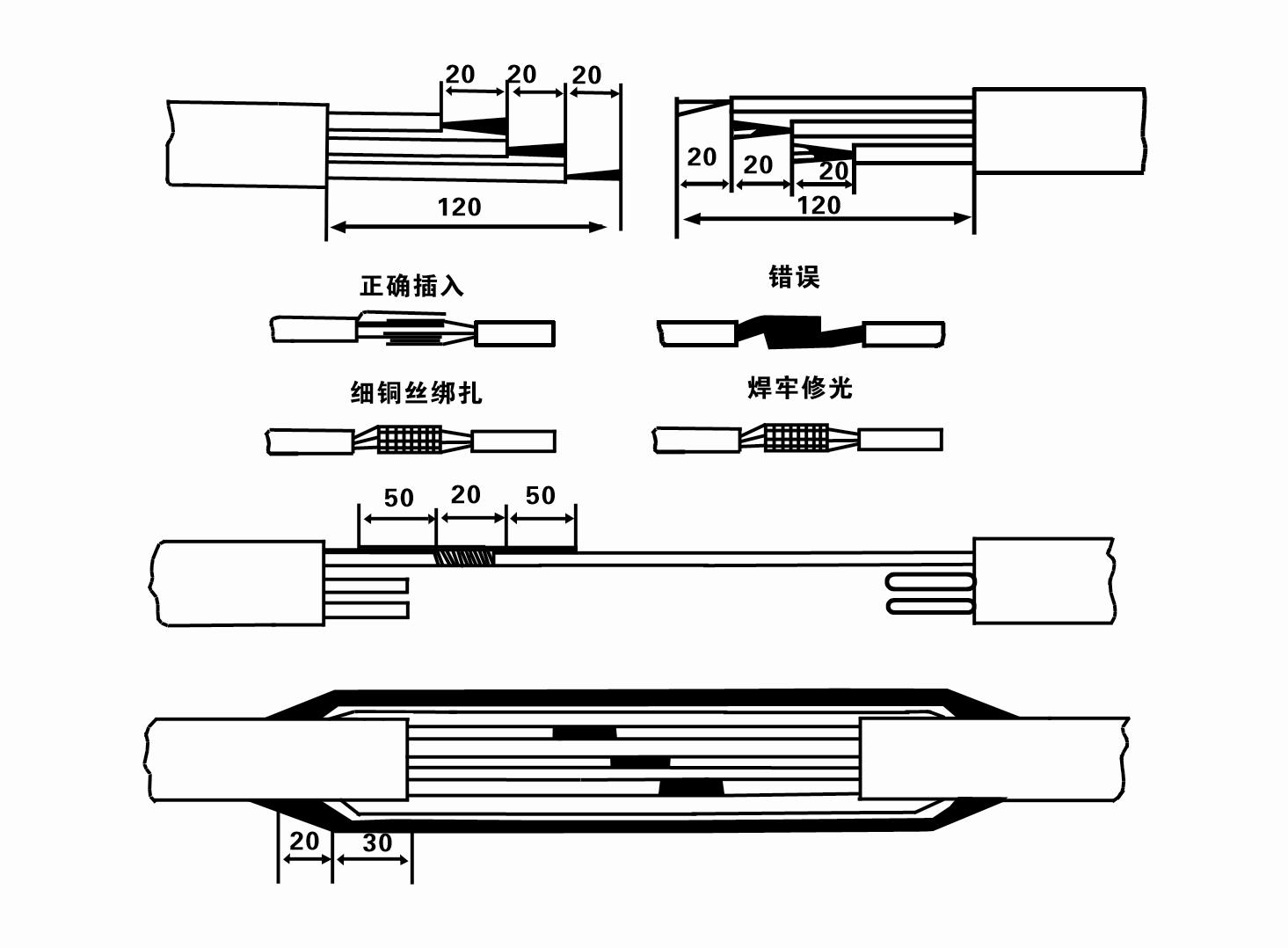
8. Whakamahi i te mita maha ki te tirotiro mena kei te hono nga waea-waa-toru me te ahua taurite te parenga DC.
9. Tirohia mehemea kua taumaha te ara iahiko me te kaha o te hurihanga, katahi ka hono atu i te pana whakamaru i te taumaha, i nga taputapu tiimata ranei. Tirohia te Ripanga 2 mo nga tauira motuhake, katahi ka ringihia he peere wai ki roto i te papu wai mai i te putanga papu wai hei whakahinuhinu i nga rapa rapa i roto i te papu, katahi ka tuu te papu hiko ruku ki runga kia mau. ka tirohia mehemea e rite ana te ahunga urungi ki te tohu urungi. Ki te kore, whakawhitia nga hononga e rua o te taura e toru-waahanga. Katahi ka whakauruhia te tātari ka takatu ki te heke ki raro i te puna. Mena ka whakamahia i roto i nga waahi motuhake (penei i nga awaawa, i nga awaawa, i nga awa, i nga harotoroto, i nga harotoroto, me etahi atu), me tika te turanga o te papu hiko.
(2) Nga taputapu me nga taputapu whakauru:
1. Kotahi te rua o nga mekameka hiki mo te neke atu i te rua tana.
2. He tripod me te teitei poutū kaua e iti iho i te wha mita.
3. E rua nga taura iri (wire ropes) ka taea te kawe i te taumaha neke atu i te kotahi tana (ka taea te kawe i te taumaha o te huinga katoa o nga papu wai).
4. Tāutahia kia rua ngā rawhi (splints).
5. Nga wrenches, hama, wiriwiri, taputapu hiko me nga taputapu, aha atu.
(3)Tautanga papu hiko:
1. Ko te hoahoa whakaurunga o te papu hiko ruku e whakaatuhia ana i te Whakaaturanga 2. Ko nga rahinga whakaurunga motuhake e whakaatuhia ana i te Ripanga 3 "Rarangi o nga Rarangi Whakamutunga o te Pump Hiko Rakau".
2. Ko nga papu hiko ruku me te upoko iti iho i te 30 mita ka taea te whakairi tika ki roto i te puna ma te whakamahi i nga ngongo me nga taura waea, etahi atu taura hemp ranei ka taea te kawe i te taumaha katoa o te miihini, nga paipa wai, me te wai i roto i nga paipa.
3. Ko nga papu me te upoko neke atu i te 30 mita te whakamahi paipa maitai, a ko te raupapa whakaurunga e whai ake nei:
①Whakamahia he rawhi hei rawhi i te pito o runga o te wahanga papu wai (kua honoa te motini me te papu wai i tenei wa), hikitia me te mekameka iri, ka ata herea ki roto i te puna tae noa ki te kuhua te rawhi ki te upoko o te puna ka tango mekameka iri.
② Whakamahia etahi atu rawhi hei rawhi i te paipa, hikitia me te mekameka iri kia 15 cm te tawhiti atu i te flange, ka ata whakaheke. I waenganui i te flange paipa me te flange papu Whakanohoia te papa rapa ki te waahi ka whakakoia te paipa me te papu kia rite ki nga tutaki, nati me nga horoi puna.
③ Whakaarahia te papu ruuma kia paku, tangohia te rawhi i te pito o runga o te papu wai, herea te taura ki te paipa wai me te riipene kirihou, ka ata herea ki raro kia tuu te rawhi ki te upoko puna.
④Whakamahia taua tikanga ki te here i nga paipa wai katoa ki roto i te puna.
⑤I muri i te hono o te taura arataki ki te pana whakahaere, ka hono atu ki te hiko hiko e toru nga wahanga.
(4) Nga mea hei tohu i te wa o te whakaurunga:
1. Mēnā ka kitea he āhuatanga tāmii i te wā e mahi ana te kumara, huri, kumea ranei te paipa wai kia pai ai te taunga. Ki te kore tonu e mahi nga momo mahi, tena koaKaua e tohe te papu ki raro kia kore ai e pakaru te papu hiko ruku me te puna.
2. I te wa o te whakaurunga, me whakanoho he papa rapa ki te taha o ia paipa me te whakakaha kia rite.
3. Ka tukuna te papu wai ki roto i te puna, me tuu ki waenganui o te paipa puna kia kore ai e rere te papu ki te pakitara o te puna mo te wa roa, ka wiri te papu, ka tahia, ka wera te motini. .
4. Whakatauhia te hohonutanga o te papu wai ki raro o te puna i runga i te rere o te onepu me te parapara o te puna. Kaua e tanu te papu ki te paru. Ko te tawhiti mai i te papu wai ki raro o te puna ko te tikanga kaua e iti iho i te 3 mita (tirohia te Whakaahua 2).
5. Ko te hohonutanga o te urunga wai o te papu wai kia kaua e iti iho i te 1-1.5 mita mai i te taumata wai hihiri ki te kohanga uru wai (tirohia te Whakaahua 2). Ki te kore, ka ngawari te pakaru o nga papa papu wai.
6. Ko te hiki o te papu wai e kore e iti rawa. Ki te kore, me whakauru he paera kuaha ki runga i te paipa wai o te upoko o te puna ki te whakahaere i te rere o te papu ki te waahi rere reiti kia kore ai te motini e nui te utaina me te wera na te nui o te rere.
7. I te wa e rere ana te papu wai, me noho tonu te whakaputanga wai me te ara, kia mau tonu te naianei (i raro i nga tikanga mahi kua whakatauhia, ko te tikanga kaua e neke atu i te 10% o te waa kua tohua), kaore he wiri, he haruru ranei. Mena he mate kino, me whakamutu te miihini kia kitea te take me te whakakore.
8. I te wa e whakauru ana, whakarongo ki te whakatakotoranga o te waea motika motika (tirohia te Whakaahua 2). Ina he paipa rino te paipa wai, arahina mai i te rawhi o te upoko puna; ina he paipa kirihou te paipa wai, arahina mai i te tohu whenua o te papu hiko.
- 1.Kua oti te whakaurunga o te papu submersible, tirohia ano te aukati i te aukati me te kawe i nga wahanga e toru mai i te whakawhiti, tirohia te taputapu me te timata i te hapa hononga taputapu, ki te kore he raruraru, ka taea te timata i te whakamatautau, i muri i te timatanga o te taputapu. e tohu ana i nga panui ahakoa he nui ake i te pereti ingoa kua tohua te ngaohiko reiti me te naianei, tirohia te haruru papu me te wiri ahuatanga, he mea noa nga mea katoa ka taea te mahi.
- 2.Ko te mahi tuatahi o te papu mo nga haora e wha, me tutakina tere te whakamatautau i te aukati waiariki o te motini, kaua e iti iho i te 0.5 megaohm te uara.
- 3.After te katinga papu, kia timata i muri i te wā o te rima meneti, ki te aukati i te tīwae wai i roto i te putorino e kore i tino reflux meinga e te nekeneke nui nāianei, me te burnout.
- 4.After te papu ki te mahi noa, i roto i te tikanga ki te roa tona ora ratonga, ki te tirohia i te ngaohiko supply, mahi nāianei, me te ātete mātao he noa, ki te kitea te āhuatanga e whai ake nei, kia tutakina tonu rapurongoā.
- - i roto i nga ahuatanga kua tohua, ko te waa kua neke atu i te 20%.
- - te taumata wai hihiri ki te waahanga uru wai, ka puta he wai mokowhiti.
- - papu ruku te wiri nui, haruru ranei.
- - he iti ake te ngaohiko tuku i te 340 volts.
- - ka wera te ngongo i tetahi wahanga.
- - kino paipa wai.
- - He iti ake i te 0.5 megaohm te motini ki te parenga waiariki.
- 5.Waehanga wae:
- (1)untie cable tether, remove the pipeline part, remove the wire plate.
- (2)screw down the water bolt, put out the motor cavity water.
- (3)remove the filter, loosening the coupling fixed motor shaft fixed screw.
- (4)screw down the inlet joint and motor bolt, the pump and motor separate (separation attention will unit mat flat, prevent the pump shaft bending)
- (5)pump disassembly sequence is: (see figure 1) inlet joint, impeller, diversion shell, impeller...... check valve body, dismantle the impeller with special tools will first fix the conical sleeve loosening, the disassembly process to avoid the pump shaft bending and each bump.
- (6)motor disassembly process is: (see figure 1) the motor placed on the platform, from the bottom of the motor in turn removed double head bolt (pull rod bolt) on the nut, base, shaft head lock nut, thrust plate, key, lower guide bearing seat, double head bolt, and then take out the rotor (pay attention not to damage the wire package) finally removed the connecting section and upper guide bearing seat.
- (7)unit assembly: before assembly should be the parts of the rust, dirt clean, each mating surface and fastener coated with sealant, and then in turn according to the reverse sequence of disassembly assembly (after assembly motor shaft up and down momentum is about one millimeter), after assembly, the coupling should be flexible, and then the filter screen test machine.
- 6.submersible pump every operation for a year, or less than a year of operation but the submersible time has reached two years, should be proposed in accordance with the fifth paragraph of the well to be dismantled and repaired, replace the worn parts.
This product is a brand new submersible pump, suitable for a variety of occasions for pump work needs. In order to ensure the long-term use and stable performance of the product, the user needs to clean the water in the motor cavity of the pump after use (especially in winter to prevent the motor from freezing), coil up and tie the cable, and then store the product in an environment free of corrosive substances and gases, with the temperature kept below 40 °C in the room. In addition, if the submersible pump is not used for a long time, special attention should be paid to prevent rust to protect the service life of the product. This submersible pump will provide users with convenient and efficient pump solutions to ensure the safe and stable operation of the pump equipment.
- Kaipupuri
- Karekau kakau
- Karekau rakau rapa
-
mowhiti hiri
01 Te urunga wai hohonu
02 Te tuku wai teitei
03 wai maunga
04 wai pourewa
05 Te whakamakuku ahuwhenua
06 te whakamakuku maara
07 te urunga wai o te awa
08 wai whare

